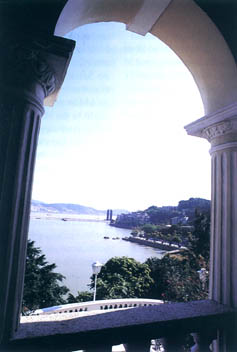 Slide by Joaquim de Castro
Slide by Joaquim de Castro
Urbanism and the safeguarding of built heritage are today, on the threshold of the 21st century, disciplines and concepts that are always present in governmental plans and wider strategies.
Knowing how, why and for whom to protect, are questions that imply a deep knowledge of the built heritage, of restoration processes, of the methodologies that should guide the elaboration of studies and projects of urban renewal and of its social existence.
In the past, especially in Portugal, the protection of buildings and complexes was selective, and complete cosmetic operations were performed in order to protect what was old or beautiful and typically tourist-oriented, like Óbidos Village.
Macao did not suffer the great destruction of the last war and has always been far from the most important decisions of the central powers in Lisbon. Despite all this, it managed to find the conditions for the timely study and planning of its urban fabric, in such a way as to generate dwelling conditions for the whole population - bearing in mind the physical space available, a mere 20 km or so.
The social and urban history of Macao is, in fact, a typical example of a city that has grown at the whim of great economic interests, certainly welcomed when used to the benefit of the people.
However, that rapid growth was achieved, since the early eighties, at the price of the destruction and demolition of several buildings which could have been rehabilitated and given new uses and purposes, through careful planning of appropriate spaces for the city's expansion.
The new expansion with the reclamation areas of ZAPE and NAPE, presented, in my view, a very harmful element in the urban plan of the city, for they cut the whole dialogue between the river and the sea, in contrast to what has been done in Mediterranean and riverside towns.
A lot has been written and published about the growth and the history of the city of Macao, but the truth is: the history of a city is not exclusively made by the compilation of dates and facts. It is also made by the interconnection of all the agents who have an interest in its harmonious evolution, among which the administration of the territory should always act as arbitrator in all decisions.
The city of Macao grew spontaneously, driven by private interests, which are also a source of wealth for this land, but whose goals should not outweigh public needs. The continuous destruction of our natural and urban environment is simply unacceptable.
The city's identity, its urban scale, habits, customs and traditions have systematically been replaced by other concepts of urbanism, where the exterior signs of wealth are an acquired privilege and a very unusual way of living.
Will there be time and space... to design urban environments and to rescue the desirable qualities?
A city, like a house, represents a life style, in which men and women are the beginning and the end; and that is translated into the social, cultural and political identity of urban agglomerations.
The recent demolition of the Carmelite Convent for the construction of a building that will once again alter the scenery and outline of the city; the urban example of NAPE; the exaggerations and outrages that have been built in Taipa; the new building of dubious architectonic quality in the old centre, near the Ruins of São Paulo and the Largo do Senado (Senate Square); and the frontages constructed on Hac-Sa Beach are examples that should be avoided in the future, since they bring no credit to the identity of Macao.
Anyway, the purpose should not be to maintain the city in a broad, desert-like museum space, as the President of Leal Senado (Senate) recently announced, but to plan, program, order and safeguard the territory of Macao, with flexible and dynamic instruments.
If this simple concept of urban planning is not put into effect, if the civic powers responsible for the urban administration of the city do not become aware, and, moreover, if the architectural profession does not harmonise economic concerns with architectural work, then this city, just like many others, will lose its identity for good, even if the Administration maintains its efforts to rehabilitate the existing buildings that are symbols of a recent past and real examples of an urban identity.
Translated from the Portuguese by PHILOS - Comunicação Global. Lda. www.philos.pt
*Bachelor of Architecture, Escola Superior de Belas-Artes de Lisboa (1980). Also studied at the Ecole Supérieure des beaux-arts in Paris. Further studies in Municipal Planning and Urban Renewal, and currently preparing a doctoral thesis in Urban Management. From 1992-98, worked as an architect for the Urban Planning and Construction Divisions of the Leal Senado in Macao, then joined the staff of the Ministry of Territorial Planning and Administration (Portugal).
start p. 211
end p.